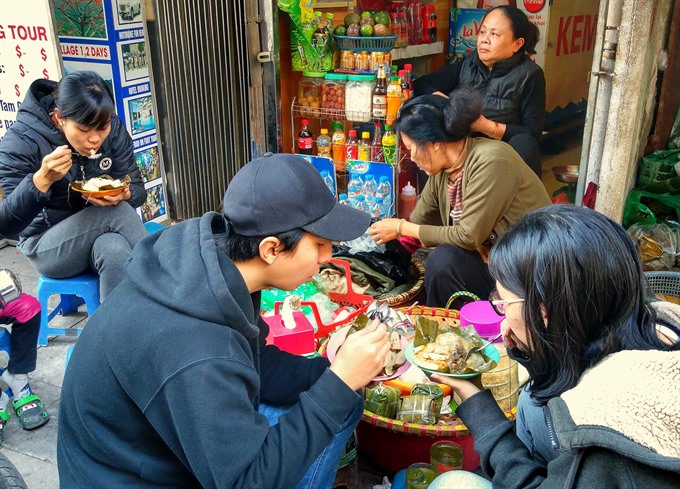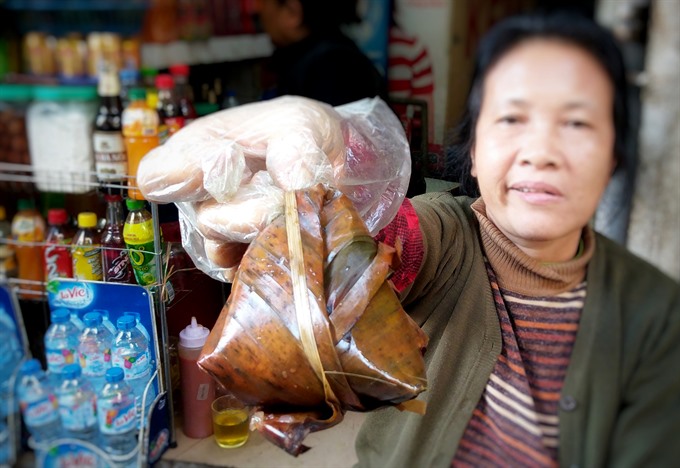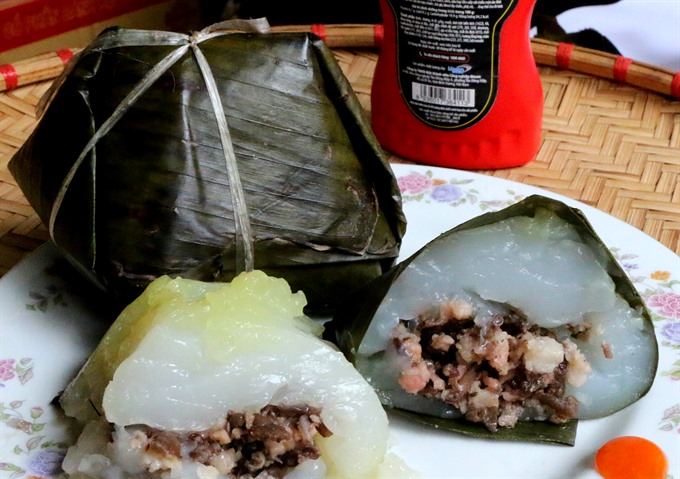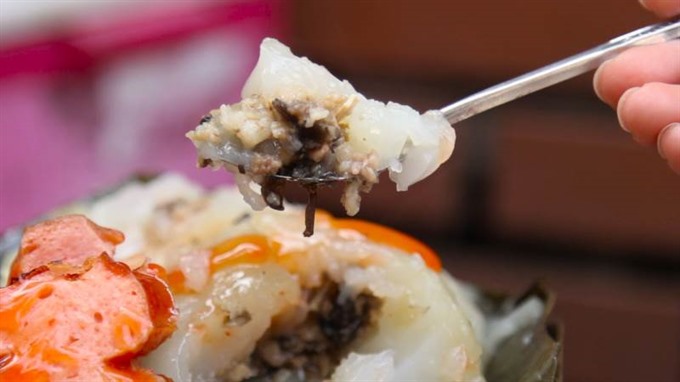 Life & Style
Life & Style

Among the myriad Vietnamese dishes made with rice, be it main courses, side-dishes or snacks that are meals in themselves, the softest gluey texture belongs to the bánh giò (rice dough dumpling with minced pork and wood ear mushrooms inside).
 |
| Studious snack: While the cake is a popular dish in Hà Nội, it is particularly favoured by students, for whom it is a tasty, affordable snack. As a result, many food stalls near schools sell this delicacy. — VNS Photo Đoàn Tùng |
Hồng Vân
Among the myriad Vietnamese dishes made with rice, be it main courses, side-dishes or snacks that are meals in themselves, the softest gluey texture belongs to the bánh giò (rice dough dumpling with minced pork and wood ear mushrooms inside).
As both main versions of the New Year celebrated in the country, based on Gregorian and Lunar calendars, approach, many Vietnamese citizens begin, mentally and actually, rubbing their hands in anticipation of treating themselves to snacks that seem to be at their tastiest best in winter.
These include the bánh chưng (square sticky rice cake), bánh giầy (white flat cake made of glutinous rice with or without mung beans inside), bánh rán (fried pancake), bánh tôm Hồ Tây (deep fried shrimp cakes in west lake) and bánh giò (rice dough dumpling with minced pork and wood ear mushrooms).
The last mentioned snack, the bánh giò, is favoured as a breakfast dish and as an after-school supper dish for children.
A bánh giò served hot stands alongside a bowl of steaming hot, aromatic phở as dishes of choice on a misty, chilly morning in the capital city.
 |
| Plastic glove, natural cover: The pyramid-shaped rice dough dumpling is wrapped in layers of banana leaves. — VNS Photo Đoàn Tùng |
To appreciate its lure, imagine you are tucking yourself into a warm blanket, thinking it is too cold to go out for food. It is at this time that you hear the itinerant bánh giò vendor shouting out his ware. Just the thought of biting into the hot juicy cake gets you out of bed in a jiffy, sending a small prayer of gratitude for the vendor appearing just at that moment.
And at just VNĐ15,000 to 30,000 (70 cents to US$1.4) each, a bánh giò offers great value for money.
The pyramid-shaped rice dough dumpling is wrapped in layers of banana leaves. Once the leaves have been removed to reveal the translucent dumpling, expert eaters just bite into it cupping the leaves in their hands, but spreading the leaves out and using a teaspoon is a far “safer” option in terms of avoiding a mess.
Once the teaspoon cuts into the cake, the filling of minced pork, wood ear mushrooms and shallots is uncovered and it can be eaten with the covering-filling proportion best left to individual preferences.
Inside the mouth, it seems to melt on the tongue, with the soft exterior and well-cooked filling making the whole cake tender and aromatic.
Eating the good rice dough, one feels like it melts in their tip of the tongue. The filling which features both fat and lean minced pork and wood ear, is often over cooked, therefore, it is very tender, soft and aromatic.
 |
| Inside story: Once the teaspoon cuts into the cake, the filling of minced pork, wood ear mushrooms and shallots is uncovered and it can be eaten with the covering-filling proportion best left to individual preferences. — VNS Photo Đoàn Tùng |
Bánh giò is sometimes served with chả, giò (Vietnamese sausage), grilled pork, chilli sauce and cucumber. In some places, bánh giò is dipped in soya sauce before it is eaten.
While the cake is a popular dish in Hà Nội, it is particularly favoured by students, for whom it is a tasty, affordable snack. As a result, many food stalls near schools sell this delicacy. It is also sold in most markets, and on many streets in Hà Nội. As it is served as breakfast or supper, some eateries offering this dish only open in the morning or late afternoon.
Madam Lũy’s bánh giò seems to be a favourite among Hanoians. The modest eatery on a corner of Trần Xuân Soạn Street near the Hôm Market is always filled with customers. The texture of rice dough is soft and smooth like jelly and the giò chả served with the cake is also highlight of the treat.
“I usually buy two cakes every time I come here. It’s still hot when I open them at home. The cake is always fresh and sells out very quickly. It has a very enticing smell and is not dry or too condense,” said 25-year-old Phạm Thu Cúc.
 |
| Serving variety: Bánh giò can be served with a number of accompaniments like chả, giò (Vietnamese sausage), grilled pork, chilli sauce and cucumber. In some regions, bánh giò is often dipped in soya sauce. — Photo foody.vn |
“Her eatery sells mostly giò and chả (Vietnamese sausage) and is famous for this food yet bánh giò is truly a highlight also,” said Cúc.
The Đông Các Street is also famous for bánh giò. The highlight of the cake served in this street lies in the accompanying dish – tasty fried sausage and grilled pork. It costs about VNĐ30,000 for a big portion of bánh giò served with Vietnamese sausage, grilled pork and cucumber.
Thụy Khuê Street is also well known for its big sized bánh giò, nearly double compared to those served in other eateries. Nguyễn Thị Nhã, a bánh giò shop owner on the street sells 500 to 600 cakes a day.
One avid customer, Hoàng Phương, 21, said: “Whenever the weather gets cold, I start missing bánh giò. It reminds of my days as a high school student, when my friends and I would gather in small eateries to enjoy this cake, almost every late afternoon in winter.” — VNS




.jpg)